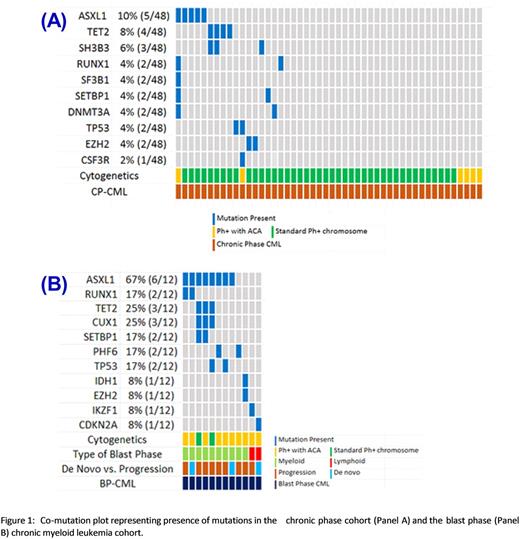Abstract
Background
Role of somatic mutations in Chronic Myeloid Leukemia (CML) is fairly underexplored. We hypothesize that clonal evolution of chronic phase CML (CP-CML) to blast phase CML (BP-CML) is molecularly driven thus augmenting on previous findings of ASXL1 being a commonly recurrent mutation in CML. Therefore, early detection of specific somatic mutations can predict progression of disease.
Methods
We performed a retrospective chart review of clinically and molecularly annotated 60 cases of CML from Moffitt Cancer Center. Genotyping was performed using next generation targeted DNA sequencing detecting for common recurrent mutations in hematological malignancies. Fisher's Exact and Student T-test were used to determine statistical significance (p-value of <0.05). All calculated p values were two sided.
Results
Total 48 patients with CP-CML and 12 patients with BP-CML were included. Median age was 56 and 53.5 years in CP-CML and BP-CML cohort, respectively. Among CP-CML cohort, 37.5% (n=18) had at least 1 mutation with ASXL1 being the most frequently mutated gene (27.7%, n=5) where 80% (n=4) were isolated and only 20% (n=1) had comutation in RUNX1 (Figure 1A). In BP-CML patients, at least 1 mutation was detected in 100% of the cases (n=12) with ASXL1 being the most frequently mutated gene (67%, n=8) (Figure 1B). In contrast to the CP-CML cohort, ASXL1 mutation co-occurred with other mutations in 87.5% of the cases (n=7). The most frequent co-occurring mutations were TET2 (37.5%, n=3) and CUX1 (37.5%, n=3) followed by RUNX1 (25%, n=2), SETBP1 (25%, n=2), TP53 (25%, n=2) and PHF6 (12.5%, n=1). Majority of the BP-CML comprised of myeloid BP (83%) where ASXL1 mutations were exclusively found. Lymphoid BP (16%, n=2) cases revealed lymphoid specific mutations in CDKN2A and IKZF1 genes.
In BP-CML compared to CP-CML, presence of ASXL1 mutation was more frequent (OR 17.2, 95% CI 3.77-78.32, p=0.002) with increased frequency of co-occurrence with at least one other mutation (OR 28.0, 95% CI 1.35-580.0, p=0.032). In BP-CML cohort, 83% (n=10) of the patients had additional cytogenetic abnormalities (ACAs) and only 16.5% (n=2) had isolated standard Philadelphia chromosome. In contrast to BP-CML, there was no correlation between presence of ACAs and presence of mutations in CP-CML cohort.
Conclusions
Although this study is comprised of a small sample size, the findings suggest that the presence of ASXL1 in CP-CML may represent an early event or "first hit", which then acquires an additional mutation or "second hit", contributing to progression to advanced phase CML. These findings need to be validated in a large prospective cohort study.
Chavez: Abbvie: Speakers Bureau; Janssen: Speakers Bureau; Kite: Speakers Bureau; Incyte: Membership on an entity's Board of Directors or advisory committees. Pinilla-Ibarz: Pfizer: Honoraria, Speakers Bureau; ARIAD: Consultancy, Honoraria; BMS: Honoraria, Speakers Bureau.
Author notes
Asterisk with author names denotes non-ASH members.


